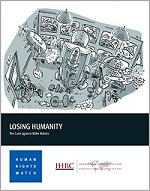 A leading campaigner against the use of unmanned 'drones' on the battlefield has warned that the pre-emptive prohibition of fully autonomous weapons is needed. Giving machines the power to decide who lives and dies on the battlefield would take defence technology a step too far, according to Steve Goose, director of the arms division at Human Rights Watch.
A leading campaigner against the use of unmanned 'drones' on the battlefield has warned that the pre-emptive prohibition of fully autonomous weapons is needed. Giving machines the power to decide who lives and dies on the battlefield would take defence technology a step too far, according to Steve Goose, director of the arms division at Human Rights Watch.
Writing for the PublicServiceEurope newsletter, he argued that a number of governments, including some European states, are pushing forward with the development of fully autonomous weapons – also known as killer robots. Furthermore, they are being developed without the populations of these countries being aware of it.
"These are weapon systems that will function without any human intervention," he wrote. "The armed robot itself will select its target and will determine when to fire. This is a frighteningly dangerous path to follow in terms of the need to protect civilians during armed conflict."
The biggest danger is that, without a 'human hand' to guide it, the weapon would destroy indiscriminately.
"Killer robots would be unable to distinguish adequately between combatants and civilians in the increasingly complex circumstances of modern battlefields, and would be unable to make proper proportionality determinations. That is, whether the military advantages of an attack exceed the potential harm to civilians. Giving machines the power to decide who lives and dies on the battlefield would take technology too far. Killer robots would lack the human qualities necessary to protect civilians and comply with international humanitarian law. They would lack the ability to relate to humans and to apply human judgment."
It would be unclear who should be held responsible for the inevitable violations of the law that would occur, he said.
These fully autonomous weapons do not yet exist, according to Goose, although their precursors do. It is estimated that sophisticated fully developed weapons may be in the field within the next two or three decades, although cruder versions may become available within a matter of years.
Human Rights Watch has released a new report, Losing humanity: the case against killer robots. It is available to download at www.hrw.org/reports/2012/11/19/losing-humanity-0.
• Read Steve Goose's full article at www.publicserviceeurope.com/article/2750/the-future-of-global-warfare-killer-robots